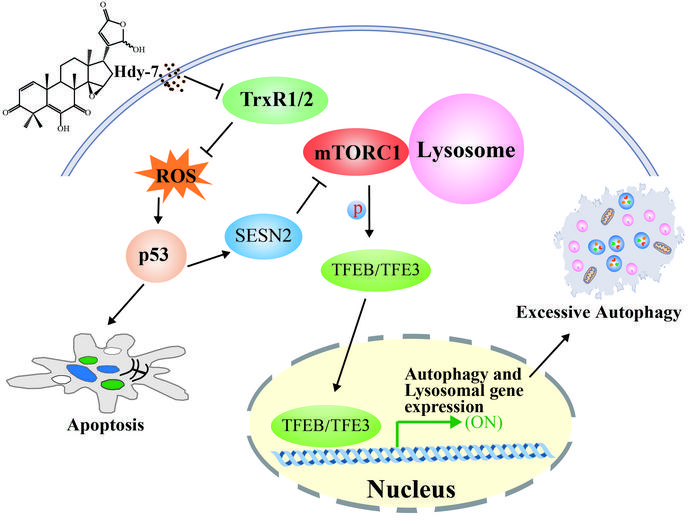
The intricate balance of cellular mechanisms is critical for maintaining cellular homeostasis, and among the myriad players involved, lysosomes have emerged as pivotal organelles. These membrane-bound structures are not only responsible for degrading intracellular waste and recycling cellular components, but they also play a fundamental role in cellular signaling. Their dynamic nature underscores their significance in regulating essential processes, particularly in eukaryotic cells where they facilitate the clearance of cellular debris while adapting to environmental stressors.
In recent studies, transcription factors TFEB and TFE3 have garnered attention for their dual role in lysosomal biogenesis and autophagy regulation. These transcription factors serve as metabolic sentinels, linking the process of autophagy with lysosomal function through the transcriptional activation of a host of genes involved in these critical cellular functions. The identification of pathways that activate or inhibit these transcription factors presents valuable insights into how lysosomal biogenesis intersects with autophagy, particularly under stress conditions where cellular stressors challenge homeostasis.
A compelling illustration of this complex interplay comes from the research conducted by Xiaojiang Hao and his team at the Kunming Institute of Botany, Chinese Academy of Sciences. They investigated isowalsuranolide, also known as Hdy-7, a natural compound extracted from the plant species Walsura yunnanensis, known for its various biological activities. Their findings emphasize the potential of natural products as probes in chemical biology, particularly in elucidating the regulatory roles they play in biological processes such as signaling pathways involved in autophagy and cell death.
Isowalsuranolide (Hdy-7) exemplifies the promising attributes of tetranortriterpenoids, compounds traditionally sourced from the Meliaceae family. This specific natural product has been shown to elicit significant anti-tumor effects, a characteristic that has drawn research interest regarding its mechanistic approach toward cancer cells. Notably, the study highlights Hdy-7’s ability to engage directly with thioredoxin reductases, TrxR1 and TrxR2, thereby disrupting their function and triggering the accumulation of reactive oxygen species (ROS) within tumor cells.
The accumulation of ROS, driven by the inhibition of TrxR enzymes, leads to a state of oxidative stress within the cells. This oxidative environment is crucial for the activation of the p53 signaling pathway, a well-known guardian of the genome known for its role in regulating cell cycle, apoptosis, and cellular responses to stress. Upon activation, p53 initiates several downstream effects, including the nuclear translocation of TFEB and TFE3. Their migration into the nucleus facilitates the expression of genes responsible for lysosomal biogenesis, thus intertwining autophagy with lysosomal function in a manner that promotes cell death.
The research findings indicate that silencing p53 or introducing ROS scavengers like NAC could mitigate the nuclear translocation of TFEB and TFE3, reducing the ensuing lysosomal biogenesis and autophagic activity. This underscores the pivotal role of the TrxR-p53-TFEB/TFE3 axis as a crucial regulatory pathway that ensures lysosomal function is preserved even amidst cellular stress.
The implications of these findings go beyond theoretical insights. The ability of Hdy-7 to induce cytotoxic effects across various cancer cell lines, including those resistant to conventional treatments like Taxol, suggests its potential as a leading compound in the search for effective cancer therapeutics. By harnessing the natural product’s capability to manipulate critical cellular pathways, researchers may open new avenues for cancer treatment strategies that specialize in targeting lysosomal dynamics and autophagy pathways.
Lysosomes have often been referred to as the “cellular recycling centers,” but this research positions them as key players in the regulatory network concerning cellular health, particularly under stress and during disease states. The activation of starvation-independent autophagy underscores the robustness of the cellular response mechanisms to ensure survival and adaptation in changing environments.
The growing understanding of the lysosome as a hub for cellular regulation invites a fresh perspective on how we approach diseases, particularly those intricately linked with cellular waste management and survival pathways like cancer. As research continues to unfold the roles of natural products in these complex biological systems, the potential for developing novel therapeutic interventions appears promising.
The published work entitled “Isowalsuranolide targets TrxR1/2 and triggers lysosomal biogenesis and autophagy via the p53-TFEB/TFE3 axis” serves as a testament to the revolutionary implications of integrating natural product chemistry with modern biological investigations. Such interdisciplinary approaches are vital for advancing our understanding of cellular mechanisms and for developing innovative strategies to combat diseases that exploit these very pathways.
This exploration of the regulatory nuances connecting lysosomal biogenesis, autophagy, and cellular homeostasis adds valuable knowledge to the existing literature. The findings reflect an urgent call to explore further the potential of natural products in revising treatment paradigms for conditions marked by dysregulated cellular mechanics, such as cancer, neurodegenerative diseases, and lysosomal storage disorders.
In conclusion, the work highlights the multifaceted roles of natural compounds in modulating critical cellular processes that govern life and disease. As research endeavors continue to unearth the therapeutic potentials buried within nature’s arsenal, the future of medicinal chemistry may very well pivot towards these organic molecules, leading to breakthroughs that could redefine the treatment landscape.
Subject of Research: Regulation of lysosomal biogenesis and autophagy by isowalsuranolide.
Article Title: Isowalsuranolide targets TrxR1/2 and triggers lysosomal biogenesis and autophagy via the p53-TFEB/TFE3 axis.
News Publication Date: [Insert Date].
Web References: [Insert URL].
References: [Insert References].
Image Credits: ©Science China Press.
Keywords: lysosomal biogenesis, autophagy, Hdy-7, TrxR, ROS, p53, TFEB, TFE3, cancer therapy, natural products, cellular homeostasis.
Tags: autophagy induction in cancercellular homeostasis and signalingenvironmental stress impact on cellsisowalsuranolidelysosomal function and biogenesismechanisms of cancer treatmentnatural small molecules in cancer therapyplant-derived compounds in medicineresearch on Walsura yunnanensisTFEB and TFE3 rolestranscription factors in cellular stressTrxR1/2 inhibition






